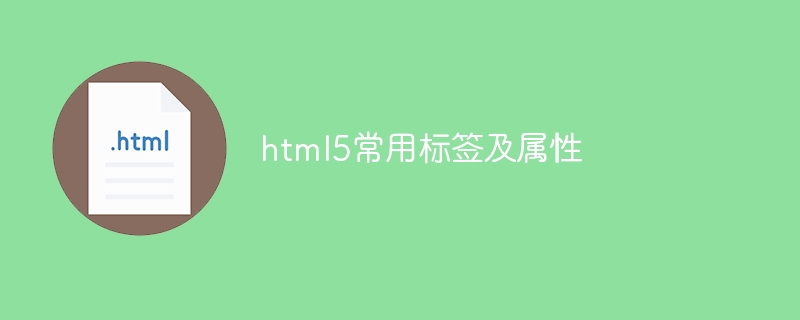html5 common tags and attributes
HTML5 tags can create rich websites, including headers (<header>), navigation (<nav>), content blocks (<article>) and modal dialog boxes (<dialog>) . Properties are used to enhance semantics and functionality, such as unique identifiers (id), CSS classes (class), submission names (name), and placeholders (placeholders).

HTML5 common tags and attributes
HTML5 tags
HTML5 Introduced many new tags that can be used to create richer, more interactive websites. Here are some of the most commonly used tags:
-
<header>: Contains the content of the website header, such as the website name and navigation menu. -
<nav>: Define navigation links, such as menu items and breadcrumbs. -
<section>: Represents different areas or sections on the page. -
<aside>: Indicates the sidebar or related content of the page. -
<article>: Represents an independent block of content, such as a blog post or news story. -
<figure>: Contains a picture, table, or other embedded content, and provides a title and description. -
<figcaption>: Provide a title or description for the<figure>element. -
<dialog>: Create a modal dialog box used to display important information or collect user input.
HTML5 Attributes
HTML5 There are also a number of attributes that can be added to tags to enhance their semantics and functionality. Here are some of the most commonly used attributes:
-
id: Uniquely identifies an element on the page. -
class: Assign elements to one or more CSS classes. -
style: Contains CSS styles applied directly to the element. -
type: Specifies the type of element, such as an input field or button. -
name: Specify the name of the form control for submitting data. -
value: Set or get the current value of a form control or text input. -
placeholder: Provides placeholder text for the input field to prompt the user for input. -
required: Forces the user to fill in this field before submitting the form. -
disabled: Disables an element, making it unusable. -
aria-*: Add accessibility features such as screen reader descriptions for the visually impaired.
The above is the detailed content of html5 common tags and attributes. For more information, please follow other related articles on the PHP Chinese website!

Hot AI Tools

Undresser.AI Undress
AI-powered app for creating realistic nude photos

AI Clothes Remover
Online AI tool for removing clothes from photos.

Undress AI Tool
Undress images for free

Clothoff.io
AI clothes remover

Video Face Swap
Swap faces in any video effortlessly with our completely free AI face swap tool!

Hot Article

Hot Tools

Notepad++7.3.1
Easy-to-use and free code editor

SublimeText3 Chinese version
Chinese version, very easy to use

Zend Studio 13.0.1
Powerful PHP integrated development environment

Dreamweaver CS6
Visual web development tools

SublimeText3 Mac version
God-level code editing software (SublimeText3)

Hot Topics
 1387
1387
 52
52
 How to use bootstrap in vue
Apr 07, 2025 pm 11:33 PM
How to use bootstrap in vue
Apr 07, 2025 pm 11:33 PM
Using Bootstrap in Vue.js is divided into five steps: Install Bootstrap. Import Bootstrap in main.js. Use the Bootstrap component directly in the template. Optional: Custom style. Optional: Use plug-ins.
 The Roles of HTML, CSS, and JavaScript: Core Responsibilities
Apr 08, 2025 pm 07:05 PM
The Roles of HTML, CSS, and JavaScript: Core Responsibilities
Apr 08, 2025 pm 07:05 PM
HTML defines the web structure, CSS is responsible for style and layout, and JavaScript gives dynamic interaction. The three perform their duties in web development and jointly build a colorful website.
 How to write split lines on bootstrap
Apr 07, 2025 pm 03:12 PM
How to write split lines on bootstrap
Apr 07, 2025 pm 03:12 PM
There are two ways to create a Bootstrap split line: using the tag, which creates a horizontal split line. Use the CSS border property to create custom style split lines.
 Understanding HTML, CSS, and JavaScript: A Beginner's Guide
Apr 12, 2025 am 12:02 AM
Understanding HTML, CSS, and JavaScript: A Beginner's Guide
Apr 12, 2025 am 12:02 AM
WebdevelopmentreliesonHTML,CSS,andJavaScript:1)HTMLstructurescontent,2)CSSstylesit,and3)JavaScriptaddsinteractivity,formingthebasisofmodernwebexperiences.
 How to resize bootstrap
Apr 07, 2025 pm 03:18 PM
How to resize bootstrap
Apr 07, 2025 pm 03:18 PM
To adjust the size of elements in Bootstrap, you can use the dimension class, which includes: adjusting width: .col-, .w-, .mw-adjust height: .h-, .min-h-, .max-h-
 How to use bootstrap button
Apr 07, 2025 pm 03:09 PM
How to use bootstrap button
Apr 07, 2025 pm 03:09 PM
How to use the Bootstrap button? Introduce Bootstrap CSS to create button elements and add Bootstrap button class to add button text
 How to set up the framework for bootstrap
Apr 07, 2025 pm 03:27 PM
How to set up the framework for bootstrap
Apr 07, 2025 pm 03:27 PM
To set up the Bootstrap framework, you need to follow these steps: 1. Reference the Bootstrap file via CDN; 2. Download and host the file on your own server; 3. Include the Bootstrap file in HTML; 4. Compile Sass/Less as needed; 5. Import a custom file (optional). Once setup is complete, you can use Bootstrap's grid systems, components, and styles to create responsive websites and applications.
 How to insert pictures on bootstrap
Apr 07, 2025 pm 03:30 PM
How to insert pictures on bootstrap
Apr 07, 2025 pm 03:30 PM
There are several ways to insert images in Bootstrap: insert images directly, using the HTML img tag. With the Bootstrap image component, you can provide responsive images and more styles. Set the image size, use the img-fluid class to make the image adaptable. Set the border, using the img-bordered class. Set the rounded corners and use the img-rounded class. Set the shadow, use the shadow class. Resize and position the image, using CSS style. Using the background image, use the background-image CSS property.




